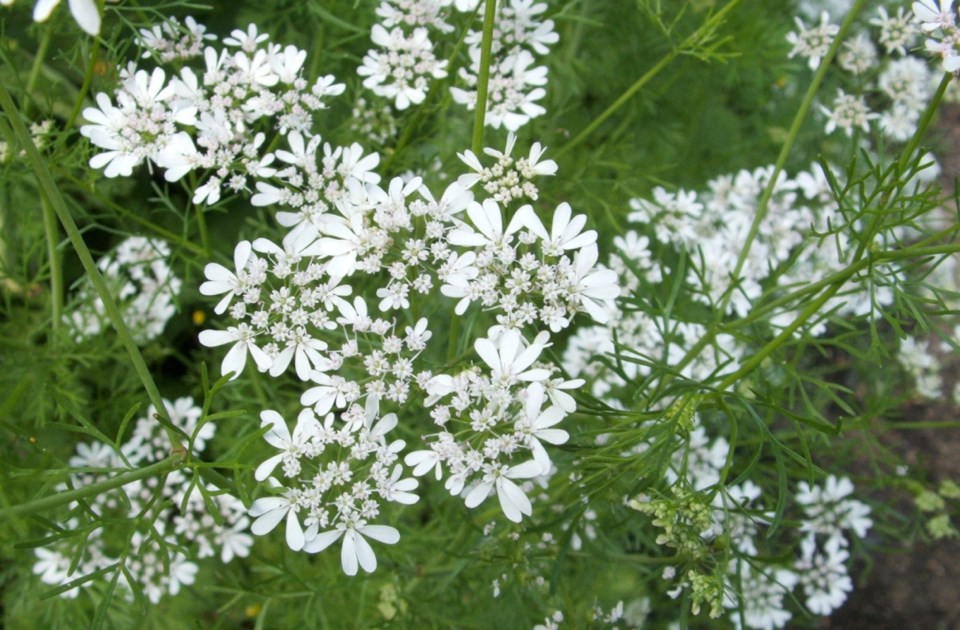Dear Helen: My husband, like you, loves growing nasturtiums every year and nurtures the ones that self-sow. This summer, however, I have pulled up the nasturtium plants because they were all infested with black aphids. I wonder what you have to say about this. It seems odd that all the nasturtiums were infested this year.
G.M.
In gardening, each year brings its own distinct characteristics. Certain plantings thrive and produce well; others don’t. Common types of pests are present in noticeably greater or lesser numbers than usual.
Black aphids turn up often on nasturtiums, globe artichokes and broad beans. I’ve seen nasturtiums recommended as a “trap crop” to attract aphids away from other plantings.
For those of us who treasure the bright and cheery presence of nasturtium foliage and flowers in the garden, there are ways for maintaining clean plants.
Grow nasturtiums in full sun. Place small scoops of used coffee grounds in among the plants. Grow small, scattered patches of nasturtiums rather than one extensive planting.
Water sprays to wash aphids off the plants can be quite effective, especially if they are repeated after two days to catch survivors. Keep plants adequately watered. Aphids are drawn to drought-stressed plants.
Plant plenty of flowers rich in pollen and nectar to nurture natural aphid enemies such as lady beetles and hover flies. The cilantro and sweet alyssum in my garden are almost always swarmed by hover (syrphid) flies.
Avoid nitrogen-rich soils for nasturtium plantings. They will remain most trouble-free in a slightly lean soil. My plantings have produced a vivid illustration of this point. I have two main nasturtium plantings this summer, both along sunny pathway edges where the soil is only very modestly fertile. Not an aphid anywhere among these plants.
Then there are the nasturtiums trailing from two oval planters perched in an old hammock by the back lawn.
Keen to have showy plants there, I must have overdone the nitrogen-rich fish compost in the containers’ planting mix. Those nasturtiums produced huge, succulent leaves and thick, juicy stems. Aphid heaven.
I’ve rid the plantings almost completely of black aphids clustered on the leaf undersides simply by cutting off infested leaves and stems and watering with a dilute solution of Alaska MorBloom, which has no nitrogen, just phosphorus and potassium.
The label formula of 0-10-10 indicates the relative ratio of nitrogen (N), phosphorus (P) and potassium (K) in the fertilizer formula on the label.
Nitrogen promotes soft, lush greenery. Phosphorus stimulates root formation and flowering. Potassium aids root growth and hardens plant cells to increase resistance to disease and insect infestation. It acts as a balance, or complement, to nitrogen. Potassium also enhances the quality of fruits, vegetables and grains.
Dear Helen: Around two weeks ago, a problem arose with our zucchini plants. The neighbours tell me their plants are similarly affected. Some sort of white stuff has appeared on the lower leaves and stems. The plants took a long time to get growing well, and I wasn’t sure how to give them a boost. I’d appreciate your thoughts.
D.F.
The white growth is a fungus called powdery mildew. It doesn’t usually begin making an appearance on squash, pumpkin and cucumber leaves until late in the summer, but the early occurrence on your plants could reflect the odd patterns of this year’s spring and early-summer weather.
Stressed plants, especially ones struggling in drought conditions, are most prone to powdery mildew infections. Infected, white-coated leaves eventually discolour and dry up.
A fertile, humus-rich soil kept evenly and adequately moist is the best investment in good growth and fruit production. It’s also the best preventive measure against diseases. Plant health and productivity can be boosted also with an early summer mulching using a nutritious compost.
Young plants, and young leaves on older plants, are largely resistant to powdery mildew infections. A second seeding in early summer yields plants that will remain largely unaffected by powdery mildew because the plants will still have fairly new leaves in late summer and early fall.
The second wave of zucchini plants often begins producing fruit just as the early plantings are doing a fast fade with their burden of mildew. Depending on the weather, the newer plants can produce young zucchinis well into autumn.
Once the mildew appears, regular rinsing of the leaves late in the morning can help to slow the spread of the disease because it washes spores from the leaves and the spores cannot germinate in the presence of water.



